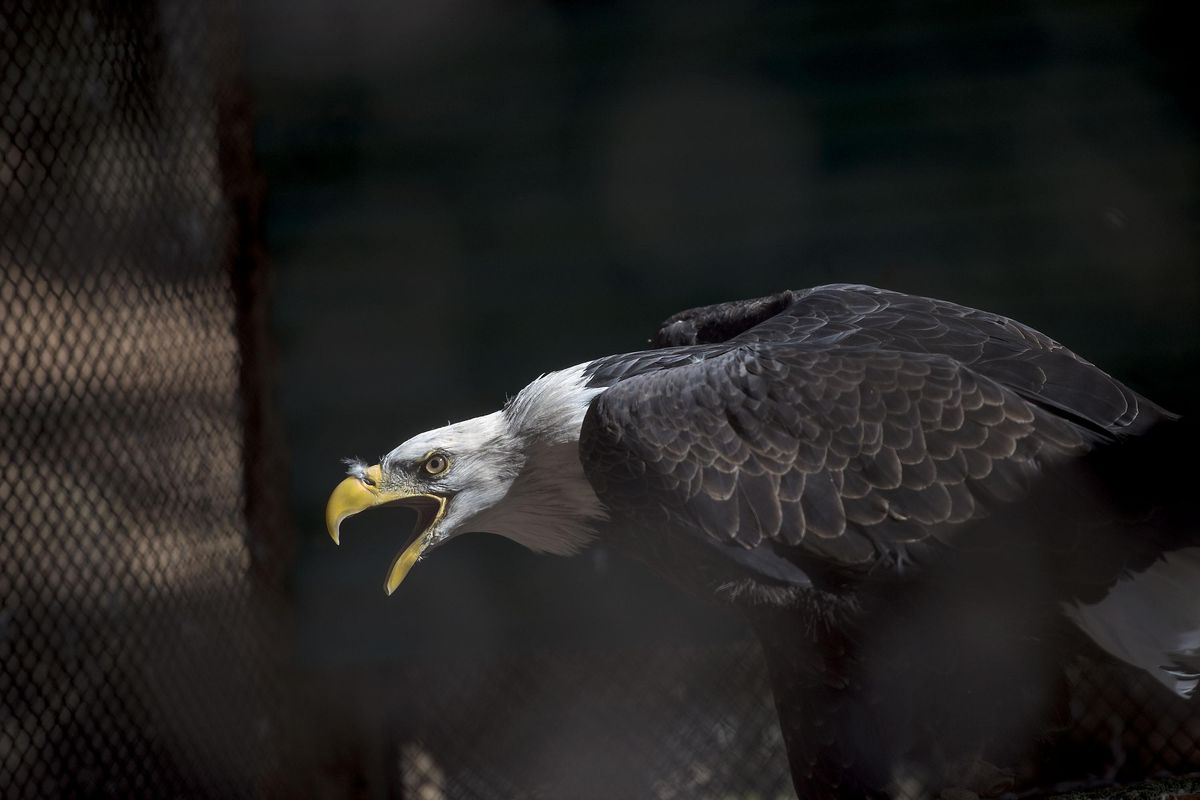Coeur d’Alene Tribe opens Northwest’s first tribal eagle aviary

The first tribal eagle aviary in the Northwest is opening on the Coeur d’Alene Indian Reservation, which will allow the tribe to keep captive bald and golden eagles and collect their feathers for ceremonial and religious use.
The House of the Bald Eagle, known as Tsetkhws Khwa Pacha’lqn in the Coeur d’Alene language, was empty on Wednesday. But the large, screened-in cage has three perches for future residents – eagles that have been injured and can’t survive on their own in the wild.
Seven other tribes have permits from the U.S. Fish and Wildlife Service to operate eagle aviaries, but all of them are located in the Southwest.
“This is good for eagle conservation, because we have more eagles than we have homes for,” said Jennifer Miller, the agency’s permits branch chief for migratory birds.
Washington, Idaho and Oregon have about 80 raptor rehabilitation facilities, which care for birds that have been shot illegally, or wounded in car collisions or other accidents. Eagles that recover but can’t live on their own are placed with zoos and other educational facilities. As bald and golden eagle populations have rebounded, the need for permanent homes for eagles also has risen, Miller said.
Eagles are long-lived birds, with lifespans of around 30 years in captivity. So, caring for an eagle is a long-term commitment, she said.
The Coeur d’Alene Tribe is partnering with the nonprofit Birds of Prey Northwest on the aviary, said Alfred Nomee, the tribe’s director of natural resources.
The aviary’s initial location is at the Birds of Prey Northwest facility near St. Maries, which will allow tribal members to receive training to care for the birds. The aviary permit requires about 300 hours of training over two years for tribal staff members who will work with the eagles.
“This lady has been a godsend for the tribe,” said Nomee, as he introduced Janie Veltkamp, Birds of Prey’s executive director.
Veltkamp has federal and state permits to rehabilitate raptors. Over the course of a year, she cares for dozens of birds at Birds of Prey Northwest, which she opened about 15 years ago.
On Wednesday, Veltkamp led a tour of the facility, which includes an infirmary for injured birds and a 120-foot long “flight run” where birds that will be released take practice flights to re-build their aerobic conditioning.
Three freezers in the shop were stocked with fish, roadkill and quail.
“Bald eagles want fish; golden eagles want meat; and peregrine falcons want quail,” Veltkamp said.
A 12- to 14-pound eagle eats “a good-sized fish every day, and two in the winter,” when the birds burn more calories to stay warm, she said.
But the stars of the tour were the eagles themselves – bald eagles with snowy heads and white tail feathers, and the darker, golden eagles. Pairs of golden eyes watched the visitors, and the piercing sound of eagle chirps filled the air.
There’s something majestic about watching the birds, said Nathan Dexter, the U.S. Fish and Wildlife Service’s Native American liason in Portland.
“When I see an eagle, I see it as a sign, an omen, a blessing that I’m in a place where I belong, where I’m protected and welcome,” Dexter said.
Under the terms of Veltkamp’s permits, only some of the birds at the facility can be displayed to the public. None of the eagles in the tribe’s aviary will be available for public viewing.
Nomee said he hopes that other Northwest tribes will consider having their own aviaries. In addition to the conservation role, having an eagle aviary allows the tribes to collect feathers when the birds molt.
“Culturally, we’re associated with these animals,” Nomee said.
Eagles are protected under the Migratory Bird Treaty Act and the Bald and Golden Eagle Act, which generally prohibits the possession and use of eagle feathers and other body parts.
Native Americans are allowed to possess and wear feathers. But getting new feathers usually requires putting in a request to the National Eagle Repository in Colorado, where feathers and other body parts are collected from dead birds.
One member of the Coeur d’Alene Tribe wanted eagle feathers for a headdress. It took about two years to get enough feathers from the repository, said Heather Keen, the tribe’s public affairs officer.
The Coeur d’Alenes and other tribes feel a deep connection to eagles, said Marlene Sproul, who is Coeur d’Alene.
“Members of the tribe would watch the eagles, because they knew where the food was,” she said.
The eagles would lead them to places where they could catch fish.
“They’re our brothers and sisters, the animal spirits,” she said.